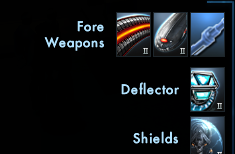 Space combat is a central element of Star Trek: Online. With the galaxy torn apart by war, clashes between the various races and factions are common, and both Starfleet and KDF captains will spend a significant proportion of their time commanding their ships in battle.
Space combat is a central element of Star Trek: Online. With the galaxy torn apart by war, clashes between the various races and factions are common, and both Starfleet and KDF captains will spend a significant proportion of their time commanding their ships in battle.
As such, your ship’s weapons are an important element of your character’s effectiveness. This article takes a look at some of the basic concepts governing weapons in STO, examines the various types available, and explains how the different factors that affect your weapons’ damage appear to function. An understanding of these areas should help you make more informed decisions about which weapons to use and how to get the best out of them in the heat of combat.
Contents:
General Concepts
Before examining the various types of starship weapons available in Star Trek: Online, there are several basic concepts that are worth considering and bearing in mind when selecting and using them.
Marks
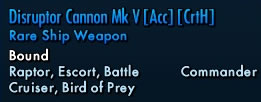 Like most equipment and items in STO, starship weapons are available in different Marks. The higher Mark of a weapon, the more powerful it is. Marks range from I to X (1-10), and the Mark of weapons you can equip is limited by the rank of your captain:
Like most equipment and items in STO, starship weapons are available in different Marks. The higher Mark of a weapon, the more powerful it is. Marks range from I to X (1-10), and the Mark of weapons you can equip is limited by the rank of your captain:
| Mark | Rank Required |
|---|---|
| I and II | Lieutenant |
| III and IV | Lt Commander |
| V and VI | Commander |
| VII and VIII | Captain |
| IX and X | Admiral |
The ‘Standard Issue’ phaser beam arrays and photon torpedo launchers that your initial ship is equipped with are effectively ‘Mk 0′ versions of those weapons.
For more information on how Marks figure into damage, see the Damage Modifiers section, below.
Bays
Starship weapons are mounted in weapon bays. Ships have two bays – one fore and one aft, each of which has slots for up to four weapons, depending on the tier and category of the ship.
(For details of how many slots the various ships have in their fore and aft bays, see Suricata’s excellent Ship Tier Charts.)
All weapon types except mine launchers can be mounted in fore bays. Only beam arrays, turrets, torpedo launchers and mine launchers can be mounted in aft bays.
There are currently no ships with port or starboard bays, and no way to adjust the facing of a weapon in a bay. All weapons must be mounted facing either in the same direction as the ship is pointing (fore bay) or in the opposite direction to which the ship is pointing (aft bay).
Firing Arcs
The various types of starship weapon have different firing arcs. In order for a weapon to be fired, the target must be within the weapon’s arc.
For example, torpedo launchers have a 90° firing arc – in order to fire a torpedo, your target must be within the front 90° of your ship (for launchers mounted in the fore bay) or the rear 90° of your ship (for launchers mounted in the aft bay).
Again, the exception is mines, which have no firing arc and do not require a target to fire, instead being dropped behind your ship.
This diagram shows the firing arcs of the other weapon types in STO when mounted in a ship’s fore bay:
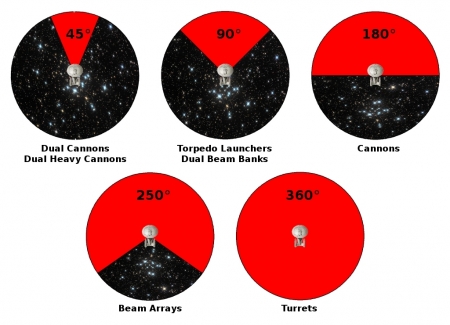
It’s important to realise that, as space combat in STO occurs in three dimensions, weapon ‘arcs’ are in fact cones, extending above and below your ship’s facing, as well as to either side.
For example, a torpedo launcher mounted in the fore bay has the following firing arc, when viewed from the side:
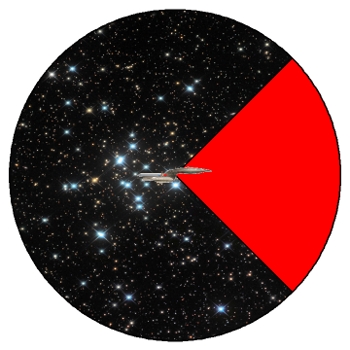
It’s also important to recognise that, due to their limited firing arcs, you can generally only bring the weapons mounted in one of your bays to bear on a target at the same time. The notable exceptions are beam arrays and turrets.
The 250° firing arcs of beam arrays mounted in the fore and aft bays overlap for 70° on either side (and above and below the ship):
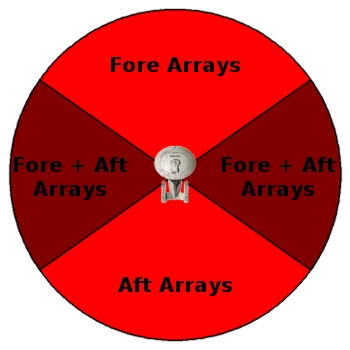
By turning sideways or positioning itself above or below a target, then, a ship can ‘broadside’ with beam arrays in both the fore and aft bays at the same time.
Turrets have a 360° firing arc, so can always be brought to bear on any target in range, whether mounted in the fore or aft bays.
There is, however, a trade-off for these advantages, as the damage output of the different weapon types is balanced against their firing arcs. In general, the wider the firing arc of a weapon type, the lower its base damage, and vice versa.
DPS and Burst vs Sustained Damage
DPS stands for Damage Per Second. As it measures the rate at which damage is dealt, it’s useful for comparing weapons with different firing speeds.
For example, consider two weapons: Weapon A does 100 damage and fires every 10 seconds, while Weapon B does 500 damage and fires every 50 seconds. Although the two weapons do different amounts of damage per hit, they both deal damage at the same rate of 10 Damage Per Second.
As a measure of a weapon’s ability to deal sustained damage, DPS is an important consideration when selecting which weapons to use. However, sustained damage is not the only important consideration in space combat in Star Trek: Online.
In some situations, the ability to deal as much damage as possible in a very short period of time – often referred to as burst damage – can be more significant.
For example, as shields regenerate every 6 seconds, whenever you knock down a target’s facing shield, you want to do as much damage as possible to the opponent’s hull in the few seconds before the next shield regeneration ‘tick’.
Likewise, when fighting a faster, more manoeuvrable opponent, it can be hard to keep them in your firing arcs. When you can bring your weapons to bear on such an opponent, you want to hit them as hard as you can before they move out of your firing arcs.
In general, the burst potential of a weapon in STO is balanced against its sustained damage – the more burst damage a weapon can deal, the lower its DPS will tend to be.
For example, quantum torpedoes do more damage than photon torpedoes of the same Mark, but have a longer recharge time and thus a lower DPS. In situations where you want to do as much damage as possible with a single shot, quantums will hit harder. However, when you are able to fire multiple torpedoes in a row, photons will deal more sustained damage over time.
Weapon Tooltips
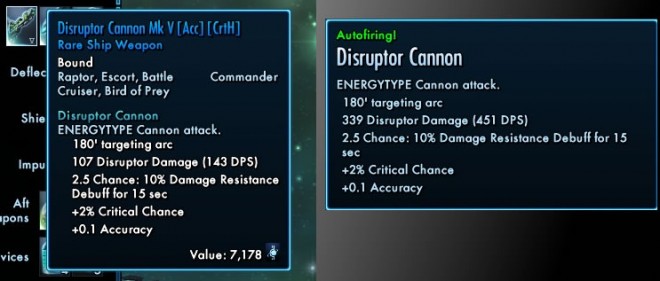
When looking at weapons in-game, it’s important to realize that some weapon tooltips are dynamic – they display the damage and DPS of a weapon modified by your captain’s stats and current weapon power level – while others are static, and display the base damage and DPS of the weapon.
- The tooltips for weapons on your hotbar and in the weapons tray on the HUD are dynamic
- The tooltips displayed for weapons in your inventory, on your ship’s status screen and in stores are static
Understanding Damage Reports
In combat, Star Trek: Online shows you how much damage your weapons are doing with each attack in two places – the small yellow numbers that float up from your target and the Combat tab in the chat window.
The small yellow numbers show only one thing – the amount of hull damage each attack is inflicting. For more detail, you need to look at the combat log in the chat window. Although it tends to scroll too fast to be particularly readable in combat, it can be worth taking a look back through the numbers after a fight.
For each of your attacks, you’ll normally see something like:
<target> absorbs X (Y) damage to <target> with Shield Array-<facing>
Your <weapon> deals A (B) <damage type> damage to <target>
- X is how much damage your attack did to the target’s shields.
- Y is how much damage would have been done to the hull if it hadn’t been applied to the shields.
- A is how much damage your attack did to the target’s hull.
- B is the total damage your attack did
The first line, with the X and Y numbers, is only shown when the target had an active shield up at the time of the attack. Y is only shown if the target’s shield or hull was resistant to the damage you did, and B is only shown when the target had an active shield at the time of the attack and/or the target’s hull was resistant to the damage you did.
For example, if you saw:
Bird-of-Prey absorbs 180 (162) damage to Bird-of-Prey with Shield Array-Front Your Phaser Array deals 18 (200) Phaser damage to Bird-of-Prey
This means that your phaser array hit the front shield facing of a Bird of Prey for 200 damage (B). 180 of the damage was applied to the shield (X) and would have caused 162 damage to the hull (Y), so the Bird of Prey has a 10% hull resistance to Phaser damage (Y/X = 0.9). The hull of the Bird of Prey took 18 damage (A), which means that the Bird of Prey’s shield has a 10% bleedthrough (20 damage bled through the shield and was reduced to 18 by the 10% resistance).
Taking the time to look through the combat log can reveal useful information about both the effectiveness of your weapons against an opponent and the type of weapons an opponent used against you.
As Starfleet officers tend to spend each rank fighting similar types of opponent in PvE, it can be handy to know what weapons are effective against them and which damage types they’re likely to use on you.
Shared Cooldowns
Cannons, torpedo launchers and mine launchers all have shared cooldowns. Firing one of these weapon types will trigger a cooldown, and you will be unable to fire another weapon of the same type until the cooldown has expired.
For example, firing a torpedo launcher triggers a 3 second cooldown on all torpedo launchers on your ship – until this cooldown has expired, you cannot fire another torpedo launcher.
As well as preventing you from firing more than one of these weapons at the same time, cooldowns limit the maximum rate of fire you can attain with multiple weapons of these types, and thus the maximum number of these weapons that can be used effectively in the same bay. These areas are discussed in more detail in the appropriate entries in the Energy Weapons and Projectile Weapons sections, below.
Weapon Skills
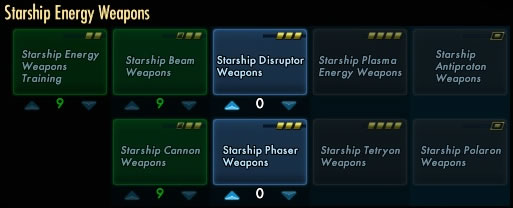
Your captain’s skills can increase the damage your weapons do.
All starship weapons are affected by three skills, one from Tier 1, one from Tier 2 and one from Tier 3-5. In general, it’s fairly easy to see which skills will affect a given weapon.
For example, a Tetryon Beam Array is an energy weapon, so it’s affected by Starship Energy Weapons Training (Tier 1), it’s a beam weapon, so it’s affected by Starship Beam Weapons (Tier 2), and it’s a tetryon weapon, so it’s affected by Starship Tetryon Weapons (Tier 4).
Note that turrets count as cannons for the purposes of skills.
For more information on skills and how skill-based stats are calculated, see the Skills: The Numbers article. For more information on how skill-based stats affect weapon damage, see the Damage Modifiers section, below.
 Weapon Abilities
Weapon Abilities
Several abilities affect the next attack you make with a specific type of weapon, or change the behaviour of a type of weapon for a short period.
For example, the Torpedo: High Yield ability increases the damage of the first torpedo launcher you fire in the next 30 seconds.
Although these abilities are not in themselves affected by your captain’s skills, the attack or weapon that they modify is affected as normal.
Energy Weapons
Energy weapons use power from the ship’s warp core to project beams or bolts of energy at their target, and come in six basic types:
| Weapon Type | Firing Arc | Base Dmg (DPS) at Mark X |
| Beam Array | 250° | 200 (160) |
| Dual Beam Bank | 90° | 266 (213) |
| Cannon | 180° | 144 (192) |
| Dual Cannon | 45° | 200 (267) |
| Dual Heavy Cannon | 45° | 401 (267) |
| Turret | 360° | 90 (120) |
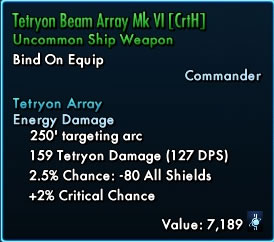 Beam Weapons
Beam Weapons
Beam weapons are the most common starship weapons in the Star Trek universe, and are the default weapons of most Federation vessels. Beam weapons can be mounted on all ships.
- Beam Arrays trade damage output for a very wide firing arc, making them easy to bring to bear on an opponent and well suited to less manoeuvrable ships like cruisers. The overlapping firing arcs of beam arrays mounted fore and aft helps to compensate for their relatively low damage, allowing beam arrays in both weapon bays to be brought to bear at the same time by turning sideways to a target and ‘broadsiding’, as described in the Firing Arcs section of General Concepts, above.
- Dual Beam Banks are more focussed offensive weapons, offering better damage output over a smaller firing arc. They are the highest damage energy weapons that can be mounted on any ship, which makes them appealing for offensively minded science vessel captains, as well as effective compliments to cannons for escort captains.
Beam weapons have no shared cooldown, and all beams that can be brought to bear on a target can be fired simultaneously. While this can give multiple beam load-outs slightly more burst potential than cannons, it can also lead to significant weapon power drain (see Weapon Power and Power Drain, below).
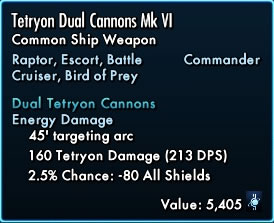 Cannon Weapons
Cannon Weapons
Cannon weapons fire multiple bolts of energy rather than beams, and are dedicated military weapons. The only Federation ships that can mount cannons are escorts.
- Cannons are similar to beam arrays, trading damage output for a relatively large firing arc. It is possible to perform limited ‘broadsides’ with fore cannons and aft beam arrays, as their arcs will overlap for 35° on either side, but given the relatively high turn rate of most of the ships that can mount cannon weapons, this is of dubious utility – much greater damage output can usually be achieved by turning to face the target and using Dual Cannons or Dual Heavy Cannons.
- Dual Cannons and Dual Heavy Cannons both trade a very narrow firing arc for high damage, and are the most powerful energy weapons. At present, the principal difference between the two is fire rate – dual cannons fire twice as many bolts per activation as dual heavy cannons, but each dual cannon bolt hits for half as much damage as a dual heavy cannon bolt, giving them the same DPS.
Cannon Cooldowns
All cannons have a 1 second shared cooldown – firing a cannon of any type prevents any other cannon from firing for 1 second – which means that multiple cannons must be fired in sequence.
There has been much discussion and debate over the relative effectiveness and optimal numbers of dual cannons and dual heavy cannons. Judging from the beta, it appears that the original intention of the design was for dual cannons and dual heavy cannons to have different optimum numbers. However, test results indicate that this is not presently the case, and that there appear to be some glitches in how multiple cannons function.
For the time being, the best option appears to be to mount dual cannons or dual heavy cannons in pairs, with two dual heavy cannons seeming to perform slightly better than two dual cannons. Adding a third will provide a slight increase in damage output, but not as much as using a different weapon instead (even a turret, the lowest damage weapon type, appears to add more damage output than a third dual or dual heavy cannon).
I’m far from convinced that multiple cannons are working right at the moment, so am going to hold off on going into the details of the testing I’ve done for now – my expectation is that there will be changes at some point, which would render it all obsolete. For the time being, if you are interested in detailed results of testing multiple cannons, I’d highly recommend the work of some of the posters to the Escort Class Starships and Tactical Officer Discussion sections of the official message boards and Legatus in particular, as my results so far seem to match his.
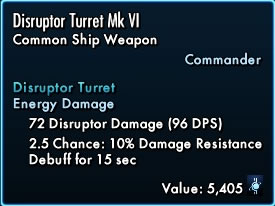 Turret Weapons
Turret Weapons
Turrets are unique in several ways. Although they fire bolts and are treated as cannons for the purposes of skills, abilities and range, they have no shared cooldown (and are not affected by the shared cooldown of cannons) and can be mounted on any ship.
They are also the only weapon type with a full 360° firing arc, but pay for this by being the lowest damage energy weapons.
Nonetheless, that 360° arc has its uses. A single turret mounted in either weapon bay will cover any gaps in the firing arcs of a ship’s other weapons, ensuring that at least one weapon can always be brought to bear on a target. They are also the only weapon type other than beam arrays that allow you to bring weapons in both bays to bear on the same target, and unlike beam arrays, don’t require ‘broadsiding’ to achieve this – turrets mounted in the rear bay can fire upon targets directly ahead of you.
Energy Types
The energy type of energy weapons has no effect on the base damage of the weapon. Instead, it determines which Tier 3-5 skill boosts the damage of weapon, which resistance the target uses to reduce damage, and gives the chance of a special effect or ‘proc’ on every shot.
Each of the six energy types has a different special effect:
| Energy Type | Special Effect |
| Phaser | Chance to disable a random subsystem (weapons, shields, engines or auxiliary) for a short period |
| Disruptor | Chance to reduce damage resistance by 10% for 15 seconds |
| Plasma | Chance to apply a fire damage effect to hull for 15 seconds |
| Tetryon | Chance to reduce all shield facings by -80 |
| Polaron | Chance to reduce all power levels by -25 |
| Antiproton | Chance to penetrate shields (?) |
I haven’t yet taken a close look at these special effects, but there are a few things I’ve noticed so far:
- The DoT (Damage over Time) effect that Plasma energy weapons have a chance to apply appears to scale with the Mark of the weapon (I’m not yet sure if it is also affected by your captain’s skills)
- The shield damage that Tetryon weapons have a chance to apply does not scale with Mark
- The power drain effect that Polaron weapons have a chance to apply doesn’t scale with Mark
- The special effect of Antiproton weapons comes from the descriptions of the Antiproton weapons available as rewards from the Admiral-3+ Borg missions – I haven’t yet been able to get hold of one of these for testing
Weapon Power and Power Drain
The damage done by energy weapons is affected by the current weapon power level of your ship – the higher your current weapon power level, the more damage your energy weapons will do.
In addition, firing energy weapons drains your current weapon power level. Power levels are replenished at a constant rate, and in general you can fire two energy weapons at the same time without suffering any significant loss in weapon power level (and thus damage). If you attempt to fire more than two energy weapons at the same time, however, you may drain your power more quickly than it is replenished, and your weapon power level will start to drop if you maintain constant fire.
Note that this effect is often more noticeable with beam weapons and turrets than with cannons, as the shared cooldown on cannons prevents them from being fired simultaneously, and thus spreads out their power drain.
There are essentially four approaches to dealing with power drain from energy weapons:
- Fire energy weapons in ‘bursts’, allowing pauses for your weapon power level to recover
- Equip items and use abilities that increase power transfer rate, which also increases the rate at which weapon power is replenished (examples include EPS Flow Regulator engineering consoles and the EPS Power Transfer ability of Engineer captains)
- Use items and abilities that increase your weapon power, either to give more power to drain or to replenish what your weapons have already drained (examples include Emergency Power to Weapons and Weapon Batteries)
- Change your weapons load-out to use fewer energy weapons
For more information on the effects of power levels, see the Ship Power Guide article. For more details on how your current weapon power level affects the damage of energy weapons, see the Damage Modifiers section, below.
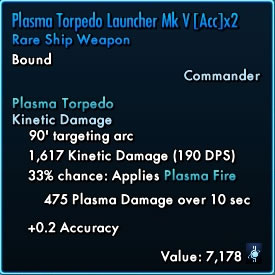 Projectile Weapons
Projectile Weapons
In contrast to energy weapons, projectile weapons launch physical objects – torpedoes or mines – which carry an explosive payload to the target.
There are some significant differences between projectile and energy weapons:
- Projectile weapon damage is not affected by your weapon power, and projectile weapons do not drain any power when fired
- The projectile type of a projectile weapon affects the weapon’s base damage and recharge rate, unlike the energy type of energy weapons
- All projectile weapons do Kinetic damage. All shields have an innate 75% resistance to Kinetic damage, so projectile weapons are far less effective at damaging shields than energy weapons
Torpedo Launchers
Torpedoes are fired much like energy weapons, but must fly to their target after being launched.
| Launcher Type | Base Dmg (DPS) at Mark X |
Recharge (sec) |
Special Effect |
| Photon | 2766 (426) | 6 | 50% chance -20 Able crew 10% chance -10 Alive crew |
| Quantum | 2894 (340) | 8 | |
| Plasma | 2171 (255) | 8 | Chance to apply Fire damage to hull for 10 sec |
| Transphasic | 2001 (191) | 10 | Increased shield penetration |
| Chroniton | 2368 (226) | 10 | -100% Flight Speed and Turn Rate for 10 sec |
| Tricobalt Mobile Device | 8940 | 60 | 2km sphere Disables targets for 2 sec |
All torpedo launchers have a 90° firing arc, and can be mounted in either the fore or aft bays.
- Photon torpedoes are the basic type of torpedo, and have a chance to injure and/or kill some of the crew of the target
- Quantum torpedoes have better burst damage than photons, but offer lower sustained damage. They have the same chance to injure and/or kill the target’s crew as photons
- Plasma torpedoes have a 33% chance to apply a Fire damage effect to the hull of the target (whether its shields are up or not) for 10 seconds. Using the Torpedo: High Yield ability with plasma torpedo launchers creates a single large plasma ball that does extreme damage but can be targeted and shot down
- Transphasic torpedoes have the lowest damage and DPS, but this can be deceptive – they have better shield penetration than other torpedoes, and initial testing suggests that against a shielded target they are actually more effective than the other, higher damage types
- Chroniton torpedoes slow the target’s movement and turn rate for 10 seconds. I haven’t been able to get hold of any for proper testing yet, however
- Tricobalt Mobile Devices are extremely powerful, and can damage and briefly disable up to 10 targets in a 2km sphere. Like High Yield plasma torpedoes, though, they can be targeted and shot down. Torpedo abilities like Torpedo: High Yield and Torpedo: Spread do not affect tricobalt mobile devices
Depending on the range and the target’s speed and maneuvering, it can take some time for a torpedo to impact – Photon, Plasma and Transphasic torpedoes all take around 10 seconds to hit a stationary target at 10km range, while Quantum torpedoes are noticeably faster, taking around 7 seconds to cover the same distance (I’ve yet to time Chroniton torpedoes or Tricobalt Mobile Devices).
Torpedo Cooldowns
All torpedo launchers have a 3 second shared cooldown (with the possible exception of Tricobalt Mobile Device Launchers, which I haven’t been able to test yet). This means that multiple launchers in the same bay must be fired in sequence, and the maximum fire rate possible is one torpedo every three seconds.
As the various launcher types have different recharge times, the number of them required to achieve this fire rate varies, and in some cases isn’t very efficient:
| Launcher | Max Number | Efficiency | Optimal Number | Optimal Rate |
| Photon | 2 | 100% | 2 | 1/3 sec |
| Quantum Plasma |
3 | 89% | 2 | 1/4 sec |
| Transphasic Chroniton |
4 | 83% | 3 | 1/3.33 sec |
- Max Number is the number of launchers of that type in the same bay required to attain the maximum firing rate of a torpedo every 3 seconds -any additional launchers in the same bay will be wasted
- Efficiency is the percentage of their normal DPS that each launcher will contribute to your total DPS output at the max number of launchers
For example, plasma torpedo launchers have a recharge of 8 seconds, so the DPS listed on their tooltip is based on them firing every 8 seconds. With three plasma launchers mounted in the same bay, each will actually be firing every 9 seconds, and thus the DPS of each launcher will be 89% of normal.
- Optimal Number is the number of launchers of that type that can be mounted in the same bay while maintaining 100% of the DPS of each
- Optimal Rate is the average rate of fire at the optimal number of launchers in the same bay
Mine Launchers
Unlike other weapons, mine launchers have no firing arc and do not require a target to to be fired. When a mine launcher is activated, a group of five mines is released. The mines move into an ‘X’ pattern and take a few seconds to arm themselves, after which they will automatically target and home in on any hostile target that passes nearby.
Like all projectile weapons, mines do Kinetic damage, and thus are significantly less effective at damaging shields than energy weapons.
| Launcher Type | Recharge (sec) |
| Photon | 12 |
| Quantum | 16 |
| Plasma | 16 |
| Transphasic | 20 |
| Chroniton | 20 |
| Tricobalt Device | 60 |
Mines offer several interesting tactical opportunities, but my testing with so far has been limited. There are a few things worth noting:
- Photon mines take 7 seconds to arm from when you activate the launcher (this may vary by type, but I need to do more testing to find out)
- Once armed, photon mines have a ’sensor range’ of 2.5km and will lock onto and home in on any hostile target that comes within that distance (again, this may vary by type, but more testing is required)
- Each individual mine appears to do around 20% of the damage of a torpedo of the same type and Mark
- Mines remain active for 60 seconds, after which they self-destruct
- It seems fair to assume that mines have similar special effects to torpedoes of the same type, but I have yet to confirm this
- Tricobalt device launchers, unlike other mine launchers, drop a single tricobalt device. It seems likely that this mine will behave in a similar fashion to a tricobalt mobile device, with a large area of effect
Mine Cooldowns
All mine launchers have a 9 second shared cooldown (with the possible exception of Tricobalt Device Launchers, which I haven’t been able to test yet). This means that multiple launchers in the same aft bay must be fired in sequence, and the maximum fire rate possible is one ‘mine deployment’ every nine seconds.
As the various launcher types have different recharge times, the number of them required to achieve this deployment rate varies, and in some cases isn’t very efficient:
| Launcher | Max Number | Efficiency | Optimal Number | Optimal Rate |
| Photon | 2 | 67% | 1 | 1/12 sec |
| Quantum Plasma |
2 | 89% | 1 | 1/16 sec |
| Transphasic Chroniton |
3 | 74% | 2 | 1/10 sec |
- Max Number is the number of launchers of that type in the same bay required to attain the maximum deployment rate of one mine cluster every 9 seconds – any additional launchers in the same bay will be wasted
- Efficiency is the percentage of their normal DPS that each launcher will contribute to your total DPS output at the max number of launchers
- Optimal Number is the number of launchers of that type that can be mounted in the same bay while maintaining 100% of the DPS of each
- Optimal Rate is the average deployment rate at the optimal number of launchers in the same bay
It’s worth bearing in mind that the efficiency and optimal numbers in the above table assume that every mine launched will hit a target, which is fairly unlikely in most situations. As such, the DPS efficiency of multiple mine launchers is perhaps less import than the deployment rate – the more mine clusters you can launch, the more chance you have of at least some of them finding a target.
Damage Modifiers
There are several modifiers that affect the damage of your weapons in space combat – the base damage of the weapon, your captain’s level in the appropriate weapon skills, any bonuses to those skills, and (in the case of energy weapons), your current weapon power level and the range to the target.
Standard Issue and Mark Bonus
Before looking at how these modifiers are applied, it’s important to understand that the base damage of a weapon appears to be the sum of two factors – the ‘Standard Issue’ damage of the weapon type and a ‘Mark Bonus’:
- The Standard Issue damage of a weapon type is the damage of a ‘Mark 0′ version of that weapon type
- The Mark Bonus is roughly 10% of the Standard Issue damage of the weapon type per Mark of the weapon, up to 100% at Mark X.
(Note that it’s not actually a smooth +10%/Mark, at least for energy weapons. I’m going to be looking at the exact Mark Bonus in more detail soon, but for the moment, +10%/Mark is a good rule of thumb.)
Damage Calculations
Based on the testing I’ve done so far, the damage of your weapons appears to be calculated as follows:
- Your captain’s total Stat Bonus for the weapon is applied as a percentage to the Standard Issue damage of the weapon
- This is added to the base damage of the weapon
- For energy weapons, the total damage is then modified by +2% for every point of weapon power over 50 or -2% for every point of weapon
This is the current damage displayed on the dynamic weapon tooltips on your hotbar or in the weapons tray, and for the mathematically-inclined can be summarised as:
(Base + (SI x (Stat/100)) x (WPow/50)
Where Base is the base damage of the weapon, SI is the Standard Issue damage of the weapon type, Stat is the total Stat Bonus and WPow is the current weapon power level.
(For details of how your captain’s Stat Bonuses are calculated, see the Skills: The Numbers article. For details on the effects of power levels, see the Ship Power Levels article. For a table of the Standard Issue damage of the various weapon types, see below.)
When an energy weapon is fired, the current damage is further modified by the range to the target:
- For beam weapons, damage is reduced by around -4% per km beyond 1km
- For cannon weapons (turrets count as cannons for the purposes of range), damage is reduced by around -8% per km beyond 2km
(For more details on the effects of range, see the Weapon Ranges article.)
A couple of examples:
A captain with a total Stat Bonus of 40 for photon torpedoes equips a Photon Torpedo Launcher Mk VI, with a base damage of 2,202 and a DPS of 339.
The Standard Issue damage for a photon torpedo launcher is 1,383. The captain’s stat bonus of 40 is applied as a percentage, giving 1,383 x 40% = 553 bonus damage.
That’s added to the base damage, giving 2,202 + 553 = 2755 damage. That’s a 25% increase over the base damage, so the DPS will be 424 (339 x 1.25).
A captain with a total Stat Bonus of 77 for tetryon beam weapons equips a Tetryon Beam Array Mk IX, with a base damage of 190 and DPS of 152. The current weapon power level of his ship is 82.
The Standard Issue damage for a beam array is 100. The captain’s stat bonus of 77 is applied as a percentage, giving 100 x 77% = 77 bonus damage.
This is added to the base damage, giving 190 + 77 = 267 damage. This is then increased by 64% due to the current weapon power level (82/50 = 1.64) to 438 (267 x 1.64). That’s a 230.5% increase over the base damage, so the DPS will be 350 (152 x 2.305).
If the captain fires at an opponent 5km away, the damage will be reduced by -16% due to range (-4% per km over 1km) and each pulse of the tetryon beam will strike the target for 368 damage (438 x 0.84).
Damage Randomisation
As becomes clear in your first space combat encounters, there’s a degree of randomness in how much an attack actually deals. I haven’t done an extensive analysis of this yet, but it appears to be somewhere in the range of +/- 5-10% for each attack.
Standard Issue Damage Values
The Standard Issue damage of each weapon type appears to be half of the base damage of a Mk X version:
| Weapon Type | Standard Issue Damage (DPS) |
| Beam Array | 100 (80) |
| Dual Beam Bank | 133 (106.5) |
| Cannon | 72 (96) |
| Dual Cannon | 100 (133.5) |
| Dual Heavy Cannon | 200.5 (133.5) |
| Turret | 45 (60) |
| Photon Torpedo Launcher | 1383 (213) |
| Quantum Torpedo Launcher | 1447 (170) |
| Plasma Torpedo Launcher | 1085.5 (127.5) |
| Transphasic Torpedo Launcher | 1000.5 (95.5) |
| Chroniton Torpedo Launcher | 1184 (113) |
Notes on Damage Calculations
The above calculations appear to match both the damage displayed by the dynamic weapon tooltips and that actually done in combat in all the cases I’ve tested so far to within a few points of damage (which I suspect is due to rounding errors brought about by the game system only displaying integer values).
Bear in mind that the dynamic tooltips don’t include range modifiers.
DPS Comparison over Range
When the Weapon Ranges article was published, Edgecase suggested a comparison of the ‘raw DPS’ of each energy weapon type over range, and this seemed like a suitable place to include one.
Besides, we haven’t had any graphs yet.
The following chart shows a comparison of the Standard Issue DPS of the various energy weapon types against range to target:
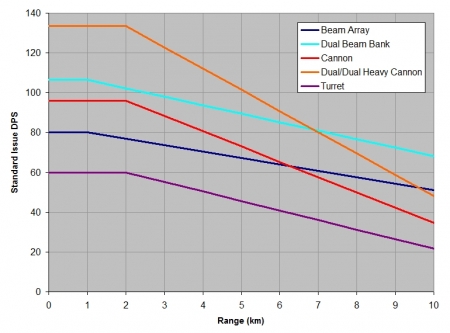
Please bear in mind that we are veering into ‘Theory Trek’ here – although the numbers used to create this graph are based on in-game test results, they include several assumptions and don’t take into account aspects of the STO combat system that are currently poorly understood (such as accuracy and any relationship it may have to range) – so this should only be used a guide for comparison.
Nonetheless, there are some things worth noting. Assuming weapons of the same Mark and equivalent Stat Bonuses:
- At ranges of around 7km and greater, Dual Beam Banks are more effective than Dual Cannons and Dual Heavy Cannons
- At extreme ranges of over 9km, Beam Arrays become comparable to Dual Cannons and Dual Heavy Cannons
- At ranges of around 6.5km and greater, Beam Arrays become more effective than Cannons
In general, then, players that favor beams – and particularly beam arrays – should try to keep a ship armed with any form of cannon as far away as possible. The longer the range, the less the DPS advantage of cannon weapons. Conversely, players who favor cannon weapons should try to close on beam-heavy opponents as quickly as possible.
Once at close range, though, the situation reverses – the cannon-heavy ship should try to maintain a range of 2km, while the beam-heavy ship (if it cannot open the range) should try to close to within 1km.
Source: The Engines Cannae Take It

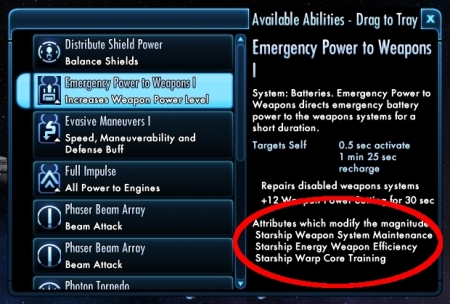
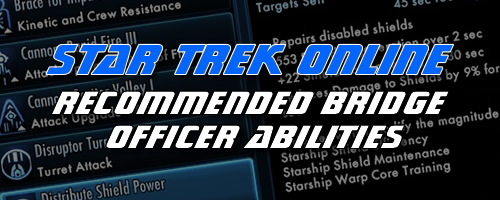
Great article . With all the useless information out there this is a breath of fresh air. I learned more in this post than the last dozen or so I previously viewed. Well done ,I will be sure to tell my friends. Thanks
Great articles on your site. Definitely the best information out there that I have found. Could you revisit this article perhaps and fill in some of the information on higher level weapons that you were unable to test previously?
Must agree. Great article. Found the info I badly needed.
Cheers mate
Love the article, but can you include the different effects of energy types or torpedo types? Like phasers to plasma and quantum to tricobalt?
Correction to my earlier post. I meant, what combinations would work best?
Great Article, hope there’s more to come.
You have incorrect information on Tricobalts.
Tricobalt devices are affected by Torp: High Yield effect, and (when there are multiple targets in the arc of the tricobalt torp launcher) can be affected slightly by Torp: Spread.
Confirmed in STF battles (Tricobalts are useful against borg)
It would be good if in the guide next to plasma, phaser, poloran etc you briefly wrote what each is actually made up of.
ie what actually is poloran etc….
Love this article. Can’t wait to see more updates.
Excellent article, especially the distance to DPS combat breakdown at the end. Thanks for taking the time to put this up.